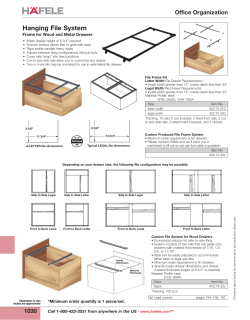
Document 135118
TV WALL UNIT FOR FLAT SCREEN TELEVISIONS If you are going to install a brand new flat screen TV on your wall, you'll want the surrounding decor to be up to scratch. Our self-assembly TV wall unit is the solution. We're certain that it will earn admiring glances from your guests, even when the TV is switched off. By the way: Assembly instructions are also available for a slimline TV console with open shelves and drawers to match this wall unit. The following assembly instructions apply to 19-mm-thick medium-density fibreboard (MDF). You must adapt the list of materials accordingly if you opt for other materials or thicknesses. Ask your DIY store or carpenter to cut the required boards to size. Our TV wall unit is mounted to the wall on special suspension rails. Spacers fitted at the bottom of the unit are used to adjust the distance between the unit and the wall. The suspension rails are fitted to the back of the rear panel and on the wall. Since the rails are always cut in pairs at a 45° angle from an MDF board, you will have matching pieces intersecting at angles, thus preventing the rear panel from slipping down or forwards. We have fastened a reinforcement panel to the back of one of the rear panels, providing a secure backing for the flat screen TV, which, if large, may be very heavy. The cables are passed through to the back of the wall unit through the cutout, which is adjusted to size. Instructions 1. Make the suspension rails Cut two suspension rails (one for the rear panel and the matching piece for the wall) at a 45° angle from a board measuring 1050 mm in length and 120 mm in width. Adjust the saw blade of the circular saw to 45° and split the suspension rail board in lengths. Using the drill and 4-mm wood drill bit, predrill holes in the suspension rails and countersink the holes. Follow the same procedure for the spacer bars and the reinforcement panel. 2. Mount the suspension rails, spacer bars and reinforcement panel The suspension rails and spacer bars must be mounted precisely to ensure that the wall unit is fitted securely and accurately. Therefore draw a triangle symbol across the abutting edges of the back of both rear panels to mark their respective positions. You thus always know what goes where at a later stage of assembly. Now place the left and right rear panels with the front facing downwards on trestles or a flat surface. Then position the suspension rails on the back in accordance with the specifications in the illustration and fasten them using the predrilled holes with a cordless screwdriver and screws (4 x 35 mm). (Ensure that you fit the suspension rails on the other rear panel at exactly the same height.) Follow the same procedure for the spacer bars and the reinforcement panel. Mount the reinforcement panel at the point where the TV will be fitted. Tip for screwing together two pieces of MDF In the piece where you want to insert the screws first, always predrill a hole that is 0.5 to 1 mm larger than the screw diameter; the hole should be countersunk for the screw head. In the piece that you are going to drill second, predrill a hole that is always 1 mm smaller than the screw diameter. The TV wall unit is now essentially complete. You can fix the matching pieces for the suspension rails to the wall and then suspend the rear panels. 3. Join the shelf sections A shelf consists of two side panels enclosed by two shelf bases. Place the sections together in the way you want to assemble them and mark their respective positions using triangle symbols on the rear edges so that you always know what goes where at a later stage of assembly. Now use the drill and 4-mm wood drill bit to predrill holes for fastening the shelf bases to the side panels. Countersink the holes on the outside to prevent the screw heads from standing out on the base surfaces. Using the cordless screwdriver and screws (4 x 35 mm), fit the shelf sections together to form a frame. Remember to countersink the screw heads properly. The holes will be filled in with putty later when the surfaces are treated. On the back of the shelf rear panel, use a pencil to trace a line 10 mm in from and around the outer edge. Along this line, use the drill and 4-mm wood drill bit to make the holes for fastening the shelf at a later stage. Countersink the holes. Now mark the positions of the four holes required to fit the shelf on the TV wall unit: In each case, the drilling point is located at 60 mm from the side edges and 80 mm from the top and bottom edges. Again, predrill the holes as described in the previous section and countersink the holes. Place the shelf frame on its visible edges, align the shelf rear panel on top so that it is flush with the edges and secure it in place with the cordless screwdriver and screws (4 x 35 mm). 4. Join the shelf to the TV wall unit You have two options: You can either arrange the shelves on the TV wall unit according to your own taste or requirements, or follow the layout in our illustration. In our layout, we have left gaps between the shelves to allow plenty of room for DVDs. Place the rear panel onto which you want to fit the shelves onto trestles, with the front of the panel facing upwards. Arrange the shelves on top and fasten them with screws and the cordless screwdriver through the predrilled holes in the rear panels 5. Prepare surfaces Take time to prepare the surfaces so they are in the best working condition possible before starting assembly. First, fill all screw holes in the MDF surfaces using putty or wood putty. Once the putty is dry (check the manufacturer's instructions), sand the area smooth using sanding paper with a grit of 120. First chamfer all MDF edges with sanding paper with a grit of 120 at a 45° angle to create a small bevel. Use a sander and sanding paper (grit of 120 – 180) to work the MDF surfaces. 6. Surface treatment To achieve a perfect finish on your furniture, paint the sections before assembly. First read the manufacturer's safety and handling instructions thoroughly. Make sure the room you are working in is well ventilated and not used for smoking, eating or drinking. Apply the priming filler with the roller or with a paint spraying system if necessary. Allow it to dry completely. You should change the paint tank if you want to apply another material with your fine spray system in the next step. MDF tips MDF surfaces are highly absorbent. For this reason, you may need to pay particular attention to the edges (i.e. apply several layers). You can skip the time-consuming task of sealing the absorbent surfaces by using MDF with a primer film. This MDF guarantees a perfect finish without fillers, at least on the surfaces. Finely sand the primed surfaces and edges; increase the grit of the sanding paper from 180 to 220 to 240. 7. Paint the visible surfaces A wide range of paints is available, of various types and price categories. The main criteria in choosing a paint should be its workability, the technical equipment you have at home, and the surface quality and durability you require. Ask for advice at a specialist retail outlet. If you are not an experienced painter, we recommend that you practice beforehand on a sample piece. You will achieve the quickest and best result with acrylic paints. They are waterdilutable and are available at any DIY store in many different colours. It is particularly quick and easy to apply them using a fine spray system. Pour the paint into the paint tank and dilute it if necessary with water. Using a test board, adjust the spray jet at the nozzle and the paint flow at the setting wheel. The spray jet can be set to horizontal or vertical for surfaces and tapered for edges. Ideally, you should first paint the inner edges, then the outer edges and then finally the surfaces; working on these with even, parallel strokes. For great DIY advice and power tools visit www.bosch-do-it.com.au
© Copyright 2025















